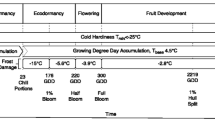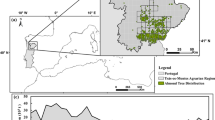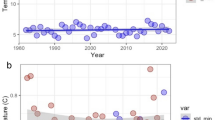Abstract
Delineating locations that are thermally viable for cultivating high-value crops can help to guide land use planning, agronomics, and water management. Three modeling approaches were used to identify the potential distribution and key thermal constraints on on almond cultivation across the southwestern United States (US), including two empirical species distribution models (SDMs)—one using commonly used bioclimatic variables (traditional SDM) and the other using more physiologically relevant climate variables (nontraditional SDM)—and a mechanistic model (MM) developed using published thermal limitations from field studies. While models showed comparable results over the majority of the domain, including over existing croplands with high almond density, the MM suggested the greatest potential for the geographic expansion of almond cultivation, with frost susceptibility and insufficient heat accumulation being the primary thermal constraints in the southwestern US. The traditional SDM over-predicted almond suitability in locations shown by the MM to be limited by frost, whereas the nontraditional SDM showed greater agreement with the MM in these locations, indicating that incorporating physiologically relevant variables in SDMs can improve predictions. Finally, opportunities for geographic expansion of almond cultivation under current climatic conditions in the region may be limited, suggesting that increasing production may rely on agronomical advances and densifying current almond plantations in existing locations.







Similar content being viewed by others
References
Abatzoglou JT (2013) Development of gridded surface meteorological data for ecological applications and modelling. Int J Climatol 33:121–131
Aguirre-Gutiérrez J, Carvalheiro LG, Polce C, van Loon EE, Raes N, Reemer M, Biesmeijer JC (2013) Fit-for-purpose: species distribution model performance depends on evaluation criteria–Dutch hoverflies as a case study. PLoS One 8:e63708
Almond Board of California (2015) Almond Almanac 2015. http://www.almonds.com/sites/default/files/content/attachments/2015_almanac.pdf. Accessed 1 August 2016.
Araújo MB, Pearson RG (2005) Equilibrium of species’ distributions with climate. Ecography 28:693–695
Averyt K, Meldrum J, Caldwell P, Sun G, McNulty S, Huber-Lee A, Madden N (2013) Sectoral contributions to surface water stress in the coterminous United States. Environ Res Lett 8:035046
Boryan C, Yang Z, Mueller R, Craig M (2011) Monitoring US agriculture: the US Department of Agriculture, national Agricultural Statistics Service, cropland data layer program. Geocarto International 26:341–358
Broxton PD, Zeng X, Sulla-Menashe D, Troch PA (2014) A global land cover climatology using MODIS data. J Appl Meteorology and Climatology 53:1593–1605
Buckley LB, Urban MC, Angilletta MJ, Crozier LG, Rissler LJ, Sears MW (2010) Can mechanism inform species’ distribution models? Ecol Lett 13:1041–1054
Challinor AJ, Ewert F, Arnold S, Simelton E, Fraser E (2009) Crops and climate change: progress, trends, and challenges in simulating impacts and informing adaptation. J Exp Bot 60:2775–2789
Connell JH, Gradziel TM, Lampinen BD, Micke WC, Floyd J (2010) Harvest maturity of almond cultivars in California’s Sacramento Valley. Options Méditerranéennes. Serie A, Seminaires Méditerranéennes 94:19–23
Covert MM (2011) The influence of chilling and heat accumulation on bloom timing, bloom length, and crop yield. Masters thesis, California Polytechnic State University, San Luis Obispo. doi: 10.15368/theses.2011.222
Crane T, Roncoli C, Paz J, Hoogenboom G (2010) Seasonal climate forecasts and agricultural risk management: the social lives of applied climate technologies. In: S. Drobot, Demuth, J. & Gruntfest, E. (Eds.), Weather and Society*Integrated Studies Compendium, National Center for Atmospheric Research, Boulder, Colorado. http://www.sip.ucar.edu/wasis/compendium.php. Accessed 4 August 2016.
Daly C, Halbleib M, Smith JI, Gibson WP, Doggett MK, Taylor GH, Curtis J, Pasteris PP (2008) Physiographically sensitive mapping of climatological temperature and precipitation across the conterminous United States. Int J Climatol 28:2031–2064
Dilts TE, Weisberg PJ, Dencker CM, Chambers JC (2015) Functionally relevant climate variables for arid lands: a climatic water deficit approach for modelling desert shrub distributions. J Biogeogr 42:1986–1997
Dobrowski SZ, Abatzoglou JT, Greenberg JA, Schladow SG (2009) How much influence does landscape-scale physiography have on air temperature in a mountain environment? Agric For Meteorol 149:1751–1758
Dourado-Neto D, Teruel DA, Reichardt K, Nielsen DR, Frizzone JA, Bacchi OOS (1998) Principles of crop modeling and simulation: I. Uses of mathematical models in agricultural science. Sci Agric 55(SPE):46–50
Elith J, Phillips SJ, Hastie T, Dudík M, Chee YE, Yates CJ (2011) A statistical explanation of MaxEnt for ecologists. Divers Distrib 17:43–57
Estes LD, Bradley BA, Beukes H, Hole DG, Lau M, Oppenheimer MG, Schulze R, Tadross MA, Turner WR (2013) Comparing mechanistic and empirical model projections of crop suitability and productivity: implications for ecological forecasting. Glob Ecol Biogeogr 22:1007–1018
Fishman S, Erez A, Couvillon GA (1987) The temperature dependence of dormancy breaking in plants: mathematical analysis of a two-step model involving a cooperative transition. J Theor Biol 124:473–483
Guisan A, Zimmermann NE (2000) Predictive habitat distribution models in ecology. Ecol Model 135:147–186
Hatfield J, Takle G, Grotjahn R, Holden P, Izaurralde RC, Mader T, Marshall E, Liverman D (2014) Ch. 6: Agriculture. In: Melillo JM, Richmond TC, Yohe GW (Eds.) Climate change impacts in the United States: the Third National Climate Assessment. U.S. Global Change Research Program, 150–174. doi:10.7930/J02Z13FR.
Hijmans RJ, Cameron SE, Parra JL, Jones PG, Jarvis A (2005) Very high resolution interpolated climate surfaces for global land areas. Int J Climatol 25:1965–1978
Hijmans RJ, Graham CH (2006) The ability of climate envelope models to predict the effect of climate change on species distributions. Glob Chang Biol 12:2272–2281
Howitt R, MacEwan D, Medellín-Azuara J, Lund J, Sumner D (2015) Economic analysis of the 2015 drought for California agriculture. Center for Watershed Sciences, University of California, Davis. https://watershed.ucdavis.edu/files/biblio/Economic_Analysis_2015_California_Drought__Main_Report.pdf. Accessed 12 August 2016
Janick J, Moore JN (1996) Fruit breeding, Nuts Vol. 3. John Wiley & Sons, New York
Jiménez-Valverde A, Peterson AT, Soberón J, Overton JM, Aragón P, Lobo JM (2011) Use of niche models in invasive species risk assessments. Biol Invasions 13:2785–2797
Johnson R, Cody BA (2015) California Agricultural Production and Irrigated Water Use. UNT Digital Library Washington D.C. http://digital.library.unt.edu/ark:/67531/metadc770633/ Accessed 26 August 2016.
Kearney M, Porter W (2009) Mechanistic niche modelling: combining physiological and spatial data to predict species’ ranges. Ecol Lett 12:334–350
Leemans R, Solomon AM (1993) Modeling the potential change in yield and distribution of the earth’s crops under a warmed climate (No. PB-94-157369/XAB; EPA--600/J-94/158). Environmental Protection Agency, Corvallis, OR (United States).
Linvill DE (1990) Calculating chilling hours and chill units from daily maximum and minimum temperature observations. Hortscience 25:14–16
Lobell DB, Burke MB, Tebaldi C, Mastrandrea MD, Falcon WP, Naylor RL (2008) Prioritizing climate change adaptation needs for food security in 2030. Science 319:607–610
Lobell DB, Field CB (2011) California perennial crops in a changing climate. Clim Chang 109:317–333
Luedeling E, Brown PH (2011) A global analysis of the comparability of winter chill models for fruit and nut trees. Int J Biometeorol 55:411–421
Luedeling E, Zhang M, Girvetz EH (2009a) Climatic changes lead to declining winter chill for fruit and nut trees in California during 1950–2099. PLoS One 4:e6166
Luedeling E, Zhang M, Luedeling V, Girvetz EH (2009b) Sensitivity of winter chill models for fruit and nut trees to climatic changes expected in California’s Central Valley. Agriculture Ecosystems and Environment 133:23–31
McKenney DW, Pedlar JH, Lawrence K, Campbell K, Hutchinson MF (2007) Beyond traditional hardiness zones: using climate envelopes to map plant range limits. Bioscience 57:929–937
McMaster GS, Wilhelm WW (1997) Growing degree-days: one equation, two interpretations. Agric For Meteorol 87:291–300
Merow C, Smith MJ, Silander JA (2013) A practical guide to MaxEnt for modeling species’ distributions: what it does, and why inputs and settings matter. Ecography 36:1058–1069
Miranda C, Santesteban LG, Royo JB (2005) Variability in the relationship between frost temperature and injury level for some cultivated Prunus species. Hortscience 40:357–361
Mitchell KE, Lohmann D, Houser PR, Wood EF, Schaake JC, Robock A, Cosgrove BA, Sheffield J, Duan Q, Luo L (2004) The multi-institution North American Land Data Assimilation System (NLDAS): utilizing multiple GCIP products and partners in a continental distributed hydrological modeling system. Journal of Geophysical Research: Atmospheres 109:D07S90.
Parker LE, Abatzoglou JT (2016) Projected changes in cold hardiness zones and suitable overwinter ranges of perennial crops over the United States. Environ Res Lett 11:034001
Pearson RG, Dawson TP (2003) Predicting the impacts of climate change on the distribution of species: are bioclimate envelope models useful? Glob Ecol Biogeogr 12:361–371
Phillips SJ, Anderson RP, Schapire RE (2006) Maximum entropy modeling of species geographic distributions. Ecol Model 190:231–259
Phillips SJ, Dudík M (2008) Modeling of species distributions with Maxent: new extensions and a comprehensive evaluation. Ecography 31:161–175
Polce C, Garratt MP, Termansen M, Ramirez-Villegas J, Challinor AJ, Lappage MG, Boatman ND, Crowe A, Endalew AM, Potts SG, Somerwill KE (2014) Climate-driven spatial mismatches between British orchards and their pollinators: increased risks of pollination deficits. Glob Chang Biol 20:2815–2828
Porfirio LL, Harris RM, Lefroy EC, Hugh S, Gould SF, Lee G, Bindoff NL, Mackey B (2014) Improving the use of species distribution models in conservation planning and management under climate change. PLoS One 9:113749
Rattigan K, Hill SJ (1986) Relationship between temperature and flowering in almond. Aust J Exp Agric 26:399–404
Roltsch WJ, Zalom FG, Stawn AJ, Strand JF, Pitcairn MJ (1999) Evaluation of several degree-day estimation methods in California climates. Int J Biometeorol 42:169–176
Rougoor CW, Trip G, Huirne RB, Renkema JA (1998) How to define and study farmers’ management capacity: theory and use in agricultural economics. Agric Econ 18:261–272
Snyder RL, Melo-Abreu JP (2005) Frost protection: fundamentals, practice and economics. Food and Agricultural Organization of the United Nations, Rome
Sorkheh K, Shiran B, Rouhi V, Asadi E, Jahanbazi H, Moradi H, Gradziel TM, Martínez-Gómez P (2009) Phenotypic diversity within native Iranian almond (Prunus spp.) species and their breeding potential. Genet Resour Crop Evol 56:947–961
Stöckle CO, Donatelli M, Nelson R (2003) CropSyst, a cropping systems simulation model. Eur J Agron 18:289–307
Syfert MM, Smith MJ, Coomes DA (2013) The effects of sampling bias and model complexity on the predictive performance of MaxEnt species distribution models. PLoS One 8:e55158
Tan SY, Mattes RD (2013) Appetitive, dietary and health effects of almonds consumed with meals or as snacks: a randomized, controlled trial. Eur J Clin Nutr 67:1205–1214
UCIPM. Almond: identify hull split. http://ipm.ucanr.edu/PMG/C003/m003fchullsplit.html. Accessed 24 June 2016.
University of California. Regional Almond Variety Trial Progress Report (1996–2006). http://fruitsandnuts.ucdavis.edu/dsadditions/Regional_Almond_Variety_Trials/. Accessed 18 January 2017.
US Department of Agriculture. National Agricultural Statistics Service (2016). Data and Statistics. https://www.nass.usda.gov/Data_and_Statistics/index.php. Accessed 6 June 2016.
USDA National Agricultural Statistics Service Cropland Data Layer (2014). Published crop-specific data layer. USDA-NASS, Washington, DC. https://nassgeodata.gmu.edu/CropScape/. Accessed 6 June 2016.
Vetaas OR (2002) Realized and potential climate niches: a comparison of four rhododendron tree species. J Biogeogr 29:545–554
Williams AP, Seager R, Abatzoglou JT, Cook BI, Smerdon JE, Cook ER (2015) Contribution of anthropogenic warming to California drought during 2012–2014. Geophys Res Lett 42:6819–6828
Woodward FI, Lomas MR, Kelly CK (2004) Global climate and the distribution of plant biomes. Philosophical transactions of the Royal Society of London series B. Biological Sciences 359:1465–1476
Yao S, Merwin IA, Bird GW, Abawi GS, Thies JE (2005) Orchard floor management practices that maintain vegetative or biomass groundcover stimulate soil microbial activity and alter soil microbial community composition. Plant Soil 271:377–389
Zavalloni C, Andresen JA, Flore JA (2006) Phenological models of flower bud stages and fruit growth of Montmorency sour cherry based on growing degree-day accumulation. J Am Soc Hortic Sci 131:601–607
Zimmermann NE, Yoccoz NG, Edwards TC, Meier ES, Thuiller W, Guisan A, Schmatz DR, Pearman PB (2009) Climatic extremes improve predictions of spatial patterns of tree species. Proc Natl Acad Sci 106(Supplement 2):19723–19728
Acknowledgements
We are appreciative of the almond expertise provided by David Doll, the feedback on early versions of the manuscript from Amber Kerr and Kripa Jagannathan, and the feedback from three anonymous reviewers.. This research was supported by the National Institute of Food and Agriculture competitive grant, award number 2011-68002-30191.
Author information
Authors and Affiliations
Corresponding author
Electronic supplementary material
Rights and permissions
About this article
Cite this article
Parker, L.E., Abatzoglou, J.T. Comparing mechanistic and empirical approaches to modeling the thermal niche of almond. Int J Biometeorol 61, 1593–1606 (2017). https://doi.org/10.1007/s00484-017-1338-9
Received:
Revised:
Accepted:
Published:
Issue Date:
DOI: https://doi.org/10.1007/s00484-017-1338-9




